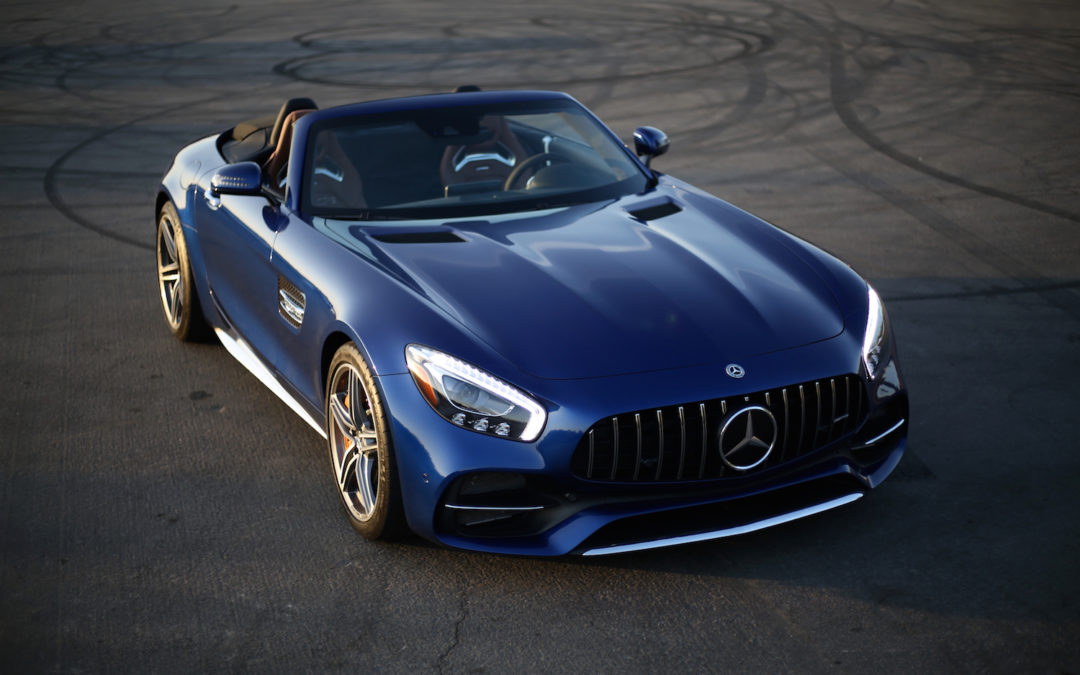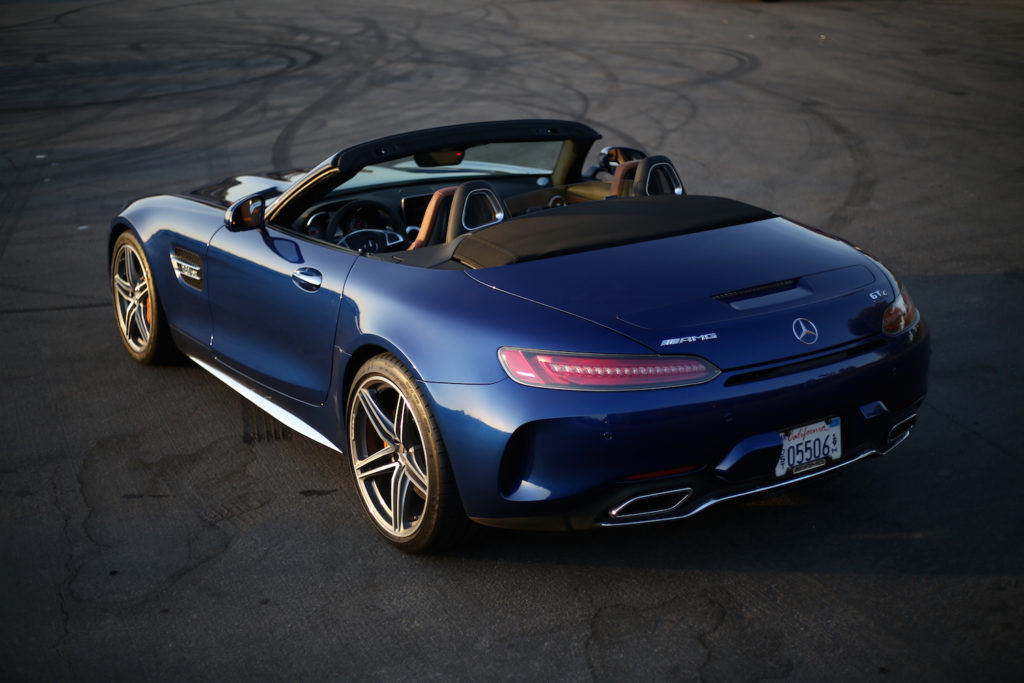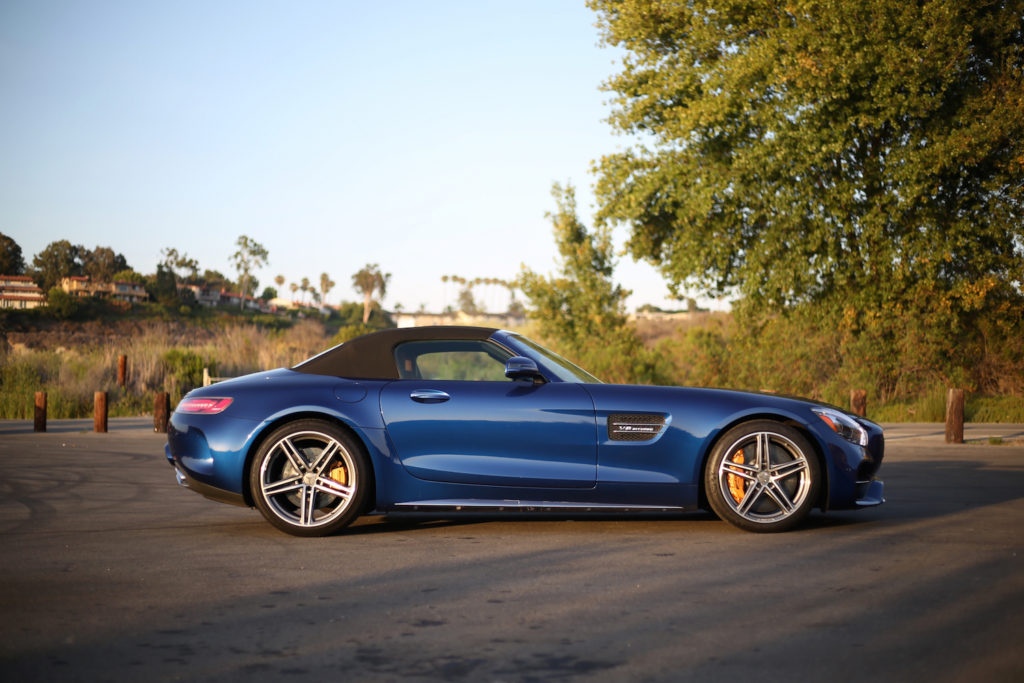Anyone who has ridden a motorcycle is familiar with the concept of controlled chaos. You’re sitting inches above an engine, and whether you have 35 or 200 horsepower at your disposal, every muscle is on edge. As it turns out, that rush isn’t exclusive to bikes; Mercedes-AMG’s GT C Roadster re-creates the thrill of riding, with minor deviations.
At present, there are seven AMG GT sports car models, and to explain the GT C Roadster’s spot in line, one really needs a good visual resource. Instead, we’ll simply say that the GT C is the hottest drop-top in AMG’s portfolio. To distinguish the GT C from the GT S Roadster, AMG (Mercedes-Benz’s in-house tuning division) utilizes the track-focused GT R’s rear-wheel steering system, wider rear fenders, gear ratios, dynamic engine and transmission mounts, and electronically controlled limited-slip differential.
The 2018 Mercedes-AMG GT C ($157,000) squares off against the Audi R8 Spyder ($177,100), Porsche 911 Turbo Cabriolet ($174,00), and Jaguar F-Type SVR Convertible ($121,900) as a high-output grand tourer (GT). Each of these manufacturers has a unique approach to topless performance, with varied engine placements, cylinder counts, forced induction methods (or lack thereof), and design principles. Though a convertible sports car is among the least practical purchases one can make, buyers will also consider usability before throwing down six figures.
Our week with the GT C Roadster was spent cruising along beaches, blitzing canyon roads, and indulging in the convertible’s premium amenities. Here’s what we learned from all that seat time.
Unlike the Porsche 911 Turbo Cabriolet and Jaguar F-Type SVR Convertible, which can easily be confused for lesser, volume-focused trims, any AMG GT model brings a sense of occasion wherever it ventures. It’s nearly impossible to ignore the AMG GT C’s expansive hood, short overhangs, squat stance, gold brake calipers, and chrome-slatted grille. Even in our tester’s deep blue paint, the low-slung roadster is like royalty among plebeian traffic. Not everyone will find the sports car’s flashy face attractive, but its tidy rump, elegant silhouette, and brushed metal wheels are details enthusiasts and commuters alike will appreciate.
Interior + Tech
There’s no other way of saying it: the GT C’s passenger quarters are tight. Visually stimulating and high quality – but tight. With the fabric soft top raised (a process that takes just 11 seconds at speeds up to 31 mph), narrow sight lines and an ultra low seating position create the impression of sinking into a hole. If ever there were a hole you’d want to fall into, though, this would be it.
A pair of perforated leather sport bucket seats sit far from one another and slightly forward of the leather-wrapped console. The chairs are heated, ventilated, multi-way adjustable, and ergonomic — if a bit light on padding. In a fun nod to the supercar’s V8 powertrain, the expansive center console arranges eight drive mode and radio controls in a V shape. Other artsy touches include four circular air vents positioned in a soft-U configuration just above brushed metal toggles for climate control and just below the 8.4-inch wide-angle Comand infotainment system. Drivers grab hold of an Alcantara wrapped steering wheel with a 12 o’clock mark and a flat bottom. A set of wheel-mounted shift paddles frames the analog speedometer and tachometer, and reconfigurable TFT display.
Mercedes-Benz’s Comand infotainment module is neither frustrating nor easy to use. Enough time spent poking around the menus and fiddling with the console-mounted scroll wheel will prepare you for quick access to multimedia, radio, and navigation functions. However, the overall layout — a mix of carousel and drop-down menus — is less than intuitive. Getting lost and finding your way out doesn’t take much time thanks to a quick processor and clear visuals, but Mercedes-Benz could use a system revamp to match Porsche or Audi’s logical interfaces.
The GT C’s other tech goodies are all, well, good. An available 11-speaker, 1000-watt Burmester surround sound system is an audiophile’s dream, a wide-view backup camera offers a clear look at cross-traffic, “airscarf” ventilated headrests shuttle warm air to your neck for chilly drives with the top down, collision prevention assist plus provides braking assistance or full automated braking in emergency situations, and pre-safe tightens safety belts, unlocks doors, and raises windows as pre-collision precautions.
Mercedes-AMG offers a few additional driver aids, including lane keeping assist, bling spot monitoring, and full-speed adaptive cruise control. These systems are among the most sophisticated of production-spec cars, giving us a glimpse into Mercedes-Benz’s plans for greater levels of driving automation.
Passenger head and legroom is plenty, but with modest cabin storage and a tiny, 6.0-cubic foot trunk, the AMG GT C isn’t cut out for extended road trips. To be fair, neither are any of the GT C’s rivals – all of which offer about the same cargo capacity. Alas, in this segment, options are either to pack light, or keep it local, lovers.
Driving Dynamics
AMG’s shopping list for the GT C sounds like the performance brand is building a race car, not a grand tourer. A 4.0-liter twin-turbocharged V8 tuned to produce 550 horsepower and 502 pound-feet of torque is paired with a seven-speed dual-clutch automatic transmission. Similar to the car’s adaptive dampers, dynamic engine and transmission mounts soften or stiffen to improve ride quality or handling efficiency. An electronically controlled limited-slip differential divvies up power to maximize cornering speed. Available carbon ceramic brakes provide excellent bite and consistent stopping distances. The rear wheels not only rotate forward (aggressively), they also pivot left and right to either tighten the turning radius at low speeds or improve stability at higher velocity.
With all that on hand, do you really want to just aimlessly cruise? Hopefully not, because the AMG GT C craves attention and exercise. A freer-flowing exhaust system rumbles in “quiet” mode and crackles when its “loud” button is pressed. The suspension never truly settles into a supple ride, despite Comfort mode’s promise of ease. Only an inch or so of pedal travel tells the engine to run, not walk. Steering response is sharp and engaging, with little difference between drive modes. It isn’t impossible to mosey along in the GT C, but it does take effort – a strange requirement for a roadster. Even the mid-engine, V10-powered R8 Spyder can be daily driven with restraint.
So the GT C isn’t suited to road trips; what is built to tackle?
Monotony. If the force of acceleration, the sound of eight cylinders hammering away, and the lightning fast reflexes of a well-tuned chassis don’t get your heart racing, we hope you have a career in base-jumping. 0 to 60 mph in 3.6 seconds and a top speed of 196 mph isn’t quite on the level of the Porsche 911 Turbo Cabriolet (3.0 seconds/ 198 mph), but it’s good enough to dust everything but a rogue hypercar.
The GT C feels even faster than it is, too. That same sense one has while riding a sport bike is felt through the rushing wind, howling exhaust note, and depth of engagement. You may not be straddling an engine, but with the V8 pushed as far towards the cabin as possible, you’re pretty darn close. With the top where it belongs (stowed neatly behind the headrests), the interior feels infinitely less cramped and visibility is as good as your peripheral vision. We didn’t think it was possible to out-excite the Jaguar F-Type SVR, but AMG has built a bonafide thrill ride.
The Verdict
The Mercedes-AMG GT C is far more vicious than its elegant bodywork lets on. The world sees a provocative silhouette and stylish interior, but you know of its thirst for corners. Brutal acceleration, precise turn-in, and tremendous grip are on the level of Lamborghini’s $450K Aventador S Roadster. Unfortunately, the GT C shares the same sacrifices as the Lambo – poor visibility with the top up, a firm ride, and limited cargo space.
Within this segment, the GT C isn’t unique in its concessions for performance. The Audi R8 Spyder and Porsche 911 Turbo Cabriolet can squeeze just 4.0 cubic feet of cargo into their front trunks, the Jaguar F-Type SVR is about as quiet as a freight train, and the McLaren 570S Spider (another would-be rival) is a far cry from luxurious. If you absolutely must have a wickedly fast convertible, we prefer the R8 Spyder for its exotic looks, wondrous V10 soundtrack, and daily drivability. However, if a more relaxed motoring experience is what you’re after, Mercedes-AMG has a winning candidate (see below).














